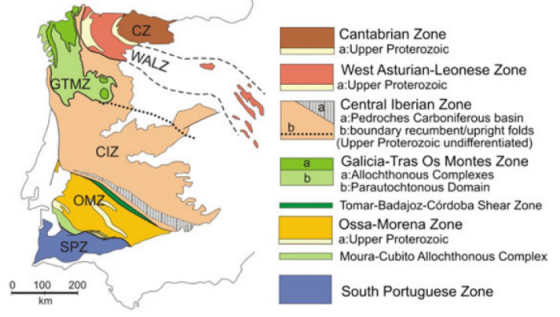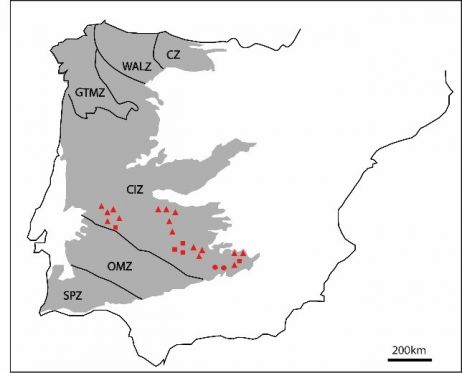Thesis ISTO/BRGM – October 2020 / September 2023
Metalloids (Sb, As) and metals (W, Hg, Au) transport and trapping processes associated with mafic magmatism within a pre-orogenic convergence setting.
PhD student: Héctor CAMPOS
Thesis director: Dr. Eric GLOAGUEN1,2.
Co-director: Pr. Stanislas SIZARET1.
1: ISTO, 2: BRGM
This project aims to improve the understanding of different processes and sources leading to the mobilization and formation of Sb, Hg±W±Au mineralisations. The study area is located in the Iberian Massif (belonging to the Variscan Belt), more specifically in the Central-Iberian zone in Spain (Figure 1)

The most important Sb, Hg±W±Au mineralizations in the Central Iberian Zone have been reported in the Badajoz, Cáceres, Ciudad Real (including the world-class Almaden Deposit), Cordoba and Jaén provinces. These deposits are presented as veins, strata-bound and within felsic volcanic rocks (Figure 2).

These mineralized systems have been spatially associated with mafic magmatism (Gumiel et al., 1976) dated at 360Ma (Hall et al., 1997; Higueras et al., 2013), but their link remains unknown.
In order to study in detail these mineralisations and to prove or refute their link with mafic magmatism, several methods will be used including: mineralogy, petrography, whole rock geochemistry, isotope geochemistry, geochronology, geophysical methods (gravimetry) and 3D geological modelling (fluid flow, heat flow, hydrodynamics), among others.
The last and one of the main objectives of this project is to create a metallogenic model that matches with the Variscan geodynamic setting.
References
Gumiel Martinez, P., Arribas Moreno, A., & Saavedra Alonso, J. (1976). Geología y metalogenia del yacimiento de estibina-cheelita de “San Antonio” Alburquerque (Bajadoz). Stvdia Geologica, 61–93.
Gumiel, P., & Arribas, A. (1987). Antimony Deposits in the Iberian Peninsula. Economic Geology, 82, 1453–1463.
Hall, C. M., Higueras, P., Kesler, S. E., Lunar, R., Dong, H., & Halliday, A. N. (1997). Dating of alteration episodes related to mercury mineralization in the Almadén district, Spain. Earth Planet, 148, 287–298.
Higueras, P., Oyarzun, R., Lillo, J., & Morata, D. (2013). Intraplate mafic magmatism , degasification , and deposition of mercury : The giant Almadén mercury deposit (Spain) revisited. Ore Geology Reviews, 51, 93–102. https://doi.org/10.1016/j.oregeorev.2012.12.004
Simancas, J. F. (2019). The Variscan Cycle. In C. Quesada & J. T. Oliveira (Eds.), The Geology of Iberia : A Geodynamic Approach (Vol. 2, pp. 1–14). Springer International Publishing. https://doi.org/10.1007/978-3-030-10519-8
Héctor Campos-PhD student
PhD student at the Institut des Sciences de la Terre d’Orléans (Earth Sciences Institute of Orleans, ISTO, University of Orleans, France). Master’s degree in Geology, Modelling and Exploration of Resources (GEOMORE) from the Université de Rennes 1 (University of Rennes 1, UR1) in France. I am also a graduate Geologist from the Universidad Nacional de Colombia (National University of Colombia, UNAL, Bogotá).
During my academic career as Geologist, I have had the opportunity to work in different projects all related with economic geology. Among them, at the UR1 I worked on the effects and the mineralogical and structural characterization of the alpine deformation over a mineralized system, representing an alpine analog of black-smoker-type hydrothermalism, in SE Switzerland. During my bachelor I worked as project assistant and also student researcher in the Research Group GEGEMA (Research Group in Economic Geology and Applied Mineralogy), on the mineralogical, geochemical characterization and geochronology of Precambrian Rocks in the Colombian part of the Amazonian Craton as well as the exploration of rare elements in this remote area. I have also participated in different field courses as well as short courses in economic geology regarding hydrothermal ore deposits.
Since my bachelor I was always interested in everything related to mineral deposits, I was chosen to work at the Senate of the Republic of Colombia for 6 months as an intern-researcher of the history of the Colombian mining legislation a its effects on both exploration and exploitation projects in the Colombian territory. Thus, giving me the opportunity to see and to study the importance of the economic geology in our society from a different point of view.
I have a long standing interest in ore deposits, geochemistry, hydrothermal systems, structural geology, magmatism, metamorphism, and other subjects related to economic geology.


